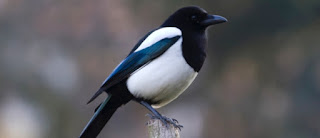Magpie
 |
| Photo credit: https://www.sciencefocus.com/nature/do-magpies-really-steal-shiny-objects/ |
The scientific name for the magpie is Pica Pica and they are part of the crow family. Their main diet is omnivorous and they are natural scavengers that source their food from any opportunity they can find. They mainly eat grassland invertebrates like beetles or caterpillars during summer and during winter they have a more plant based diet such as berries or grains. Their scavenger instinct sees them eating household scraps or pet foods and even catch small mammals and birds and sometimes young rabbits. They also take eggs out of other birds nests and consume the young. Magpies save food for later dates by making a small hole in the ground with their sharp beak, put whatever food they have in it and then cover it over to come back to when food is scarce.
They are characterised by their black-and-white plumage, long tails and their nosy, chattery nature, which along with an arrogant attitude, can leave magpies as a less than favourite creature for many people. However, I think magpies have a hidden beauty that isn't always recognised. They are very intelligent creatures and use this intelligence in many aspects of their life including scavenging, and predation. Magpies also provide a service to humans as they act as a natural pest-control by eating insects. They also have a hidden beauty within their feathers as when seen up close, their black appearance turns a purple-blue colour and has a beautiful iridescent shine.
Magpies have a fairly interesting life cycle. Whilst breeding they have territory of 12 acres but due to limited nesting sites, between 25-60% of magpies fail to breed. The bird that do not breed usually join together as a collective flock and extend their home range to around 50 acres and then may couple up. Breeding age is usually 2 years old but some birds breed as early as 1 year old. The nest they build are either high up in trees or in thorny bushes and are fairly large and domed shaped. The eggs are laid around April and are incubated for 18 or 19 days by the female. The male brings food too the female and feeds her whilst she is in the nest during this time. Once the young are born, both parents feed the young but if the food supply is low then the stronger, older nestlings will be prioritised in order to ensure at least one survives. After about 26 to 30 days they fledge and after another 4 weeks of being feed by their parents they leave the nest. After 5 months of staying in their parents territory they leave in flocks of their own. Magpies have an average life expectancy of 3 years but can live to ages much older than this. A 21 year old magpie was once discovered.
There is an ongoing superstition revolving around magpies that many people believe in. The one for sorrow nursery rhyme plays a large part in this. It claims that the number of magpies you see together determines your luck. It originated in the early 16th century where magpies where seen as a bad omen in British culture.



Comments
Post a Comment